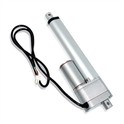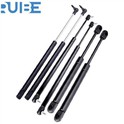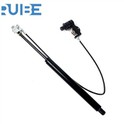In the automotive industry, gas dampers play a crucial role in ensuring a smooth and comfortable ride. As a trusted [I'll assume a normal role here, like "provider"] of Gas Damper for Car, I've received numerous inquiries about how these dampers perform in cold climates. In this blog, I'll delve into the science behind gas dampers, explore their behavior in low - temperature environments, and share some insights based on my experience in the field.
Understanding Gas Dampers for Cars
Gas dampers, also known as shock absorbers, are essential components of a vehicle's suspension system. Their primary function is to control the movement of the springs and keep the tires in contact with the road surface at all times. When a car encounters a bump or a dip in the road, the springs compress and expand. The gas damper then dissipates the energy generated by these movements, preventing the vehicle from bouncing uncontrollably.
Gas dampers operate based on the principle of fluid dynamics. They contain a piston that moves through a cylinder filled with hydraulic fluid and gas, typically nitrogen. As the piston moves, the fluid is forced through small orifices, creating resistance and damping the motion of the springs. This resistance can be adjusted depending on the design and specifications of the damper, allowing for different levels of ride comfort and handling performance. You can learn more about the Gas Damper for Car on our website.
The Impact of Cold Climates on Gas Dampers
Cold climates present unique challenges for gas dampers. As the temperature drops, several physical changes occur within the damper that can affect its performance.
Viscosity Changes in Hydraulic Fluid
One of the most significant effects of cold weather on gas dampers is the change in the viscosity of the hydraulic fluid. Viscosity refers to a fluid's resistance to flow. In cold temperatures, the hydraulic fluid in the damper becomes thicker, increasing its viscosity. This means that it is more difficult for the fluid to flow through the small orifices in the piston, resulting in increased damping force.
The increased damping force can make the ride feel stiffer and less comfortable. The vehicle may react more harshly to bumps and potholes, and the suspension may not be able to absorb shocks as effectively. In extreme cases, the increased viscosity can cause the damper to become unresponsive, leading to a loss of control and handling.
Gas Compression and Expansion
The gas inside the damper also behaves differently in cold climates. As the temperature drops, the gas contracts, reducing its volume. This can lead to a decrease in the pressure inside the damper, which in turn affects the damping characteristics.
A decrease in gas pressure can cause the damper to become less effective at controlling the movement of the springs. The vehicle may experience more body roll during cornering and more pitching during acceleration and braking. Additionally, the reduced gas pressure can make the damper more susceptible to cavitation, a phenomenon where bubbles form in the hydraulic fluid due to low pressure. Cavitation can cause damage to the damper components and further degrade its performance.
Material Properties
Cold temperatures can also affect the material properties of the damper components. Rubber seals and bushings, for example, become more brittle in cold weather, increasing the risk of cracking and leakage. Metal components may also experience thermal contraction, which can lead to misalignment and increased wear.
Performance Testing in Cold Climates
To understand how gas dampers perform in cold climates, extensive testing is required. At our company, we conduct a series of tests in controlled cold - chamber environments to simulate real - world winter conditions.


Viscosity Testing
We measure the viscosity of the hydraulic fluid at different temperatures to determine how it changes in cold weather. This data helps us understand the impact of temperature on the damping force and allows us to develop fluids that maintain optimal viscosity over a wide range of temperatures.
Damping Force Testing
We use specialized equipment to measure the damping force of the dampers at various temperatures. By comparing the damping force at normal and cold temperatures, we can evaluate the performance degradation and make adjustments to the damper design if necessary.
Endurance Testing
In addition to performance testing, we also conduct endurance tests to ensure that the dampers can withstand the harsh conditions of cold climates over an extended period. The dampers are subjected to repeated cycles of compression and expansion in cold temperatures to simulate the wear and tear they would experience on the road.
Mitigating the Effects of Cold Climates
Based on our research and testing, we have developed several strategies to mitigate the effects of cold climates on gas dampers.
Specialized Hydraulic Fluids
We use specialized hydraulic fluids that are formulated to maintain low viscosity even in cold temperatures. These fluids contain additives that prevent them from thickening, ensuring consistent damping performance in all weather conditions.
Improved Gas Charging
To address the issue of gas compression in cold climates, we have improved our gas - charging processes. We use high - quality nitrogen gas and charge the dampers to a specific pressure that takes into account the expected temperature variations. This helps maintain the optimal gas pressure inside the damper, ensuring stable damping characteristics.
Enhanced Sealing and Insulation
We have also focused on improving the sealing and insulation of our dampers. We use high - quality rubber seals that are resistant to cold - weather cracking and leakage. Additionally, we have added insulation materials to the damper housing to reduce the impact of cold temperatures on the internal components.
Other Applications of Gas Dampers
Gas dampers are not only used in cars but also in other applications, such as cabinets. Cabinet Gas Damper is another product we offer. Although the operating conditions for cabinet gas dampers are different from those of car gas dampers, they also face challenges in cold climates. The same principles of viscosity change and gas behavior apply, and we have used similar techniques to ensure their performance in low - temperature environments.
Conclusion
Cold climates can have a significant impact on the performance of gas dampers for cars. However, through extensive research, testing, and innovation, we have developed solutions to mitigate these effects. Our gas dampers are designed to provide optimal performance in all weather conditions, ensuring a smooth and comfortable ride for drivers.
If you're in the market for high - quality gas dampers for your cars or cabinets, we invite you to contact us for a procurement discussion. We're confident that our products will meet your needs and exceed your expectations.
References
- "Automotive Suspension Systems" by Colin Crolla
- "Fluid Mechanics and Hydraulics" by Frank White
- Internal research reports from our company's R & D department.






